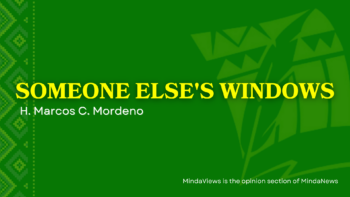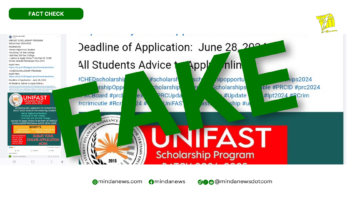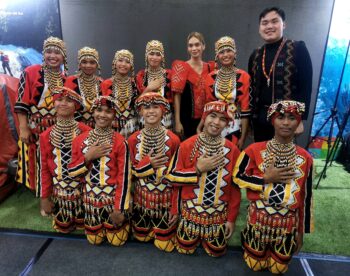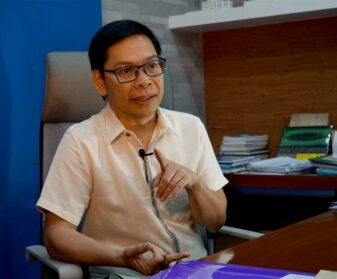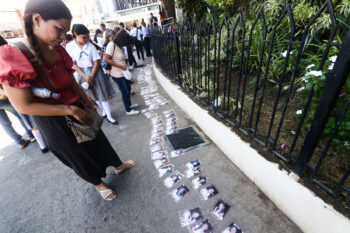TACLOBAN CITY (MindaNews/17 January) — “This looks like a war zone,” Fr. Sonny Umbac, CSsR, a confrere said as we walked the two-kilometer stretch from near the Iglesia ni Kristo church in Sto. Niňo to the airport. We were together with six other confreres, including our Provincial, Fr. Nico Perez CSsR and the Tacloban Rector, Fr. Edwin Bacaltos CSsR.
This was past 4 a.m. of Saturday, 17 January, the day Pope Francis was arriving in Tacloban City.
It has been a known fact that his State Visit and Apostolic Pilgrimage to Tacloban was the main reason he was coming to the Philippines. Because of the great significance of his visit, tens of thousands of Warays and other Pinoys from other parts of the country made sure to be in this city today.
It had started to drizzle at past 2 a.m. In the afternoon of Friday, 16 January, pilgrims were already arriving at the site of the Pope’s Mass at the airport. The security measures dictated that those wanting to be at the airport should be pre-registered so that they could be issued IDs. No IDs, no entry to the site of the Mass. However, pilgrims have to join groups and each group was assigned to be already at the site on scheduled hours. Thus, some groups already had to move to the site afternoon of Friday.
Our own group was told to be at the site before 6 a.m. (Saturday) when all gates would be closed. Thus we left the Redemptorist convent at the crack of dawn, rode till the Iglesia ni Kristo, then walked all the way to the airport along with thousands of pilgrims. Along this road were policemen coming from Bicol and Central Visayas. There were also Scouts as well as students from the universities in Tacloban who were assigned to form human barricades to control the crowd. Most had raincoats on, although some of the students were unprotected from the rains. The spirit was high as we passed them by; everyone greeted everybody even as they were all starting to get wet from the drizzle.
Walking was slow as the streets were not fully lighted, and we could not pass through the center of the roads but by the sidewalk, many parts of which were unpaved and thus starting to get quite muddy. Military, ambulance and media trucks and vehicles had the privilege of passing at the center of the road. Thus Fr. Sonny’s remark that it all looked like a war zone!
The Airport Scene
We made it to what looked like an entry to airports (given the metal detector gadgets) by 5:15 a.m. We all had to fall in line as what we brought with us (strict orders: everything be placed inside transparent plastic bags, no mineral waters, umbrella, etc.) were inspected and body searched. Imagine having to do that for an estimated 200,000 people? Fifteen minutes to 6 a.m. we found our designated area, only 30 meters away from the makeshift chapel where Pope Francis was to say Mass and right in front of a giant screen showing scenes of his visit in Manila.
Here was a stark contrast. On the screen, we see those gathered inside the Mall of Asia all comfortable and dry with their flickering lights in their hands. While we were out here in the cold, wet and shivering from the gust of winds that increasingly got stronger under the pouring of rain. Because of the dark sky, sunrise came on gradually and one could see dark clouds being blown away by Amang’s winds. It was still Signal No. 1 in Tacloban, but word was that it could be upgraded to Signal 2 before the end of the Mass.
Expectations were very high. As soon as there were airplanes that arrived, people cheered even if the Pope was not coming till around 8:30 a.m. In an earlier schedule, he was to arrive at 9 a.m. for the 10 a.m. Mass. But word was that he would arrive earlier.
With the live TV coverage, we actually saw him leaving the Papal Nuncio’s residence (in Manila), riding on a black automobile to the airport (Villamor Air Base in Pasay City), being greeted by all kinds of peoples at the airport, then going up the stairs to take his seat inside the PAL (Philippine Airlines) plane.
Strange that one felt that the close to one hour flight was both too long or too short for those of us waiting in Tacloban. Too long because of being soaked in the rain and feeling very cold, but too short because there was so much to see and hear at this ground zero of Yolanda.
There were youth groups assigned to various quadrants of the space who were singing and dancing to a few songs composed for this occasion. Crowds continued to pour into the space and soon all spaces were now covered by pilgrims. And the giant screens continued to flash scenes of the Pope’s visit which was interesting for those who were not able to watch TV of the previous days’ events in Manila.
And then, Pope Francis’ plane was seen in the tarmac and thanks to the giant TV screen in front of us, we had a ringside view of all the events that unfolded one after another: his coming down the stairs, the crowd’s growing wild seeing him in the flesh (shouting: Viva El Papa! Papa Francisco!!!), the children dancing as he passed by them (with a few boys having a vantage view of the Pope as they stood on their karang or stilts), the Pope embracing the sick and elderly and finally entering into the secluded space where he prepared for the Mass.
Change of Plans
Owing to the inclement weather, the announcement was made that the Mass will be simple and there will be no communion for the public. The highlight of the Mass was Pope Francis’ homily which touched the hearts of everyone, especially the Yolanda survivors. He spoke of Jesus Christ as the Lord, but that Jesus suffered on the cross and thus, knew what suffering was all about. That he shared the people’s suffering but that he will not abandon them.
The Pope affirmed what we all knew along: that as soon as Yolanda hit the Visayas, he was glued on TV and that he wanted to immediately come to comfort the survivors. He apologized that it took a while to get to Tacloban, but then he said that he was finally there. To which the crowd responded with a cheer!
He also referred to Mary by pointing to the statue of Nuestra Seňora dela Salvacion, a Marian devotion close to the Warays of Eastern Leyte. At some parts of the Mass, on the giant screen one sees rains falling on the statues’ cheeks, making it look as if Mary was crying. Pope Francis assured the crowd that Mary is the Mother to all who will be there to comfort them in their sufferings. (Later on at a press conference, Fr. Lombardi, the Vatican’s media head, referred to this statue as the Mother of Perpetual Help).
The winds got even stronger after the Sanctus and by the time people sang the Our Father, there was fear that some of the makeshift shelters would be blown away including the huge sound systems. By then we were soaking wet and at our feet, the water had accumulated and threatened to get all our shoes fully wet. I shivered to the bones and wondered how long I could stand the cold. But there was electric energy emanating from the Pope’s presence and one knew one could survive this once-in-a-lifetime experience.
The Mass had started past 9 a.m. and was finished just over an hour later. It ended with Archbishop John Du thanking the Pope for his visit and closing with these words: “Now you know, Your Holiness, what is the real situation here in our place!”
To this, Papa Francisco flashed his astonishing smile, although earlier at some parts of the Mass, he looked very worried and sad seeing the crowd in that kind of a situation and, perhaps, recalling the scenes of Yolanda. With the giant screen, we could see those emotions on his face very clearly and one was drawn to these emotional expressions.
As rains poured and flowed down our cheeks, tears also gently rolled down towards the wet ground that constituted what Archbishop John Du referred to as Yolanda’s Ground Zero.
Minutes after giving the final blessing, Pope Francis rode the Pope-mobile and blessed the more than 100,000 people who lined up along the 15-kilometer stretch of the highway since the crack of dawn.
The war zone had now turned into a full pilgrimage, as the crowds then followed that road to the city, feeling energized by the Pope’s presence and fully assured that they have a Holy Father whose message of mercy and compassion is authentic and true!
Why this Pope’s Impact?
Why has Pope Francis’ presence among us an astonishing event, truly awesome in its impact on most of us Filipinos? What is it about this Pope that drew the tens of thousands of Filipinos to the streets and to the sites of the events during his visit? Why would people stand for hours in the discomfort of crowd scenes for a glance of his presence which lasts only a few seconds? And why did the 300,000 people in Tacloban brave a tropical storm with rough winds and pouring rains just to gaze at him from afar?
If one had a chance to read some of the articles in the broadsheets or listen to TV anchors sharing their thoughts, there have been all kinds of theories shared to answer the above questions.
I reflected on these questions while waiting for his arrival at the Tacloban airport. I share some of the theories: he is charismatic, there is something about the manner that he smiles and reaches out to people, one could sense his deep sense of authenticity and spirituality, his presence is like that of Jesus himself, he shows so much compassion to those who need this most, he calls a spade a spade and is not afraid to speak up his mind especially on issues related to injustice and corruption, he has deep solidarity with the poor (that part of his homily where he spoke of “the poor being at the center of the Gospel, if you take away the poor, there is no Gospel” will go down as a classic quote) and the humanity that he expresses so boldly.
The Need for a Wise and Gentle Leader
It is a convergence of all these, but I believe there is one other element that adds up to the charisma which naturally draws our people’s deep affection for him. He is the wise, elderly person we so desperately need and wish to have in our families, our communities, our nation. Thus the name that traverses from Papa Francisco to Lolo Kiko. He is the wise and gentle father-grandfather figure that we all long to have in our lives.
In our pre-conquest era until colonization and globalization depleted the traditional role of the elder, there was reverence for the datu, the timoay and the Bae if they were wise in dealing with ethical and moral questions, kind in relating to their people, merciful to those who defy the tribe’s customary laws, gentle in dealing with the weak and intuitive in knowing what direction to take.
Today our social institutions are so lacking of this kind of elders-leaders. And this is especially so in our political arena.
In the past we had the Rectos, Taňadas, Dioknos, Salongas. We had a President like Ramon Magsaysay, despite his limitations. We had good men in our Supreme Court down to our local governments. But look at Malacaňang now, at Congress, in our courts and our LGUs. What kind of elders-leaders do we have?
Are there media people we can look up to? Public intellectuals from our universities, civil society organizations and NGOs? And what about our church leaders across the various faith traditions? In this lacunae, we project our desire for such a wise and gentle father figure to whoever enters the scene who projects a profile of being an elderly statesman, leader, or church official with the kind of wisdom, compassion and witness the people in desperate times.
It is in this context that Pope Francis appears in our landscape. And we totally embrace him as we all intuit that he is the ONE who our heart desires to lead us. How lucky we are to have him as our Pope and privileged are we that he came to visit us. As good friend Leah Vidal texted me after his Mass at the Tacloban airport: “We r really so lucky 2 b given this Pope n r lifetime”.
He came, he saw, he conquered
He came, he saw and was “conquered.” He definitely came despite the dire weather forecasts. Considering that, unlike most Filipinos especially those residing along the typhoon belt, Pope Francis has not experienced being on a storm’s harm’s way, it was very courageous of him to ride the plane and have a bumpy ride to Tacloban City. And because he came, as he promised, the 300,000 people in this city had an experience of a lifetime.
But, how much of the impact of Yolanda’s devastation did he see? In his extemporaneous homily at the airport this morning (he did ask the crowd if he could speak in Spanish as he wanted to speak from his heart and not read the prepared text), he affirmed what only a few knew before. (In late January 2014, when a group of us Redemptorists met Archbishop John Du, he intimated to us that the Pope was thinking of coming to Tacloban). It was only when the CBCP (Catholic Bishops Conference of the Phlippines) announced his coming sometime in August, that the public had an inkling that he had thought of coming to Tacloban right after Yolanda’s tragic visit.
Indeed, he saw the wide TV coverage of Yolanda’s wrath and how it created such havoc on the lives of the Warays. He wanted to make the trip as soon as possible, but it was not meant to be. It took 14 months before he, finally, arrived here at Ground Zero.
At his homily, he apologized for the delay but that he was so pleased that, finally, he was here. A wide cheer arose from the big crowd with these words, one of the many during the course of his homily.
But how much did he actually see directly with his own eyes and not mediated by a TV screen? Alas, something happened in the manner that his visit to the Philippines was finally organized. What was to be the main reason for his visit turned out to last only for four hours, when he landed at 8:47 p.m. and left at 12:47 p.m. instead of 5 p.m.
Considering that he was in our country for almost three days, the four hours seem like a side show to the main events in Manila. No wonder many thought that the Pope’s visit was once again hijacked by imperialist Manila. (But this is another matter, which I am sure will come up in various conversations and opinion writing in the days to come.)
Fortunately, the four-hour visit was fraught with risks and complications that it became truly an astonishing moment in our contemporary history as a nation. Because of Typhoon Amang, the four-hour visit turned out to be awesome, even if it lasted only for a short moment. The Pope actually was seeing what happens when there is a typhoon, even if Amang isn’t in the same category as Yolanda. He saw how the coconuts and trees sway with the rough winds, how fragile the temporary buildings could be and how the people can suffer with nature’s wrath. He actually experienced being in the midst of a typhoon whose capacity to create havoc got stronger every minute as the Mass progressed.
Wearing a yellow raincoat over his chasuble only made it look very symbolically dramatic. Given the circumstances, the stage was practically bare. The blue mantle of the altar was about to be blown along with the antique candleholders. There was just the statue of Nuestra Seňora dela Salvacion in front and a traditional crucifix on the amakan wall. There was nothing else on the altar: no curtains, no flowers, no frills of any kind. Everything was reduced to the minimum. Even the liturgy was reduced to its bare minimum, so that only a few were given communion. Fortunately, all the songs were in Waray which provided an inculturated element to the liturgy.
The Pope might have seen a little bit of the landscape as the plane landed. He would have been told that the airport was beside Cancabato Bay, from where the waters rose during the storm surge. He must have seen many buildings that have been left unrepaired. But the government did a clean-up job of the communities along the route of the Pope-mobile. And with the crowds lining the streets, he would not have seen many of the damaged homes. Besides, the route did not go through streets like Magallanes where most of the devastation is still visible, given the very slow rehabilitation program of building new homes.
On the way to the Palo cathedral, there was a plan for him to pass by the humble home of a family who survived Yolanda. But this was cancelled, when it was decided that his departure for Manila was moved from 5 p.m. to no later than 1 p.m He did meet with the 30 survivors (who according to Cardinal Tagle managed to tell the Pope who and what they lost during the mega-disaster) but eating lunch with them was cancelled. Still, according to Cardinal Tagle, this experience of listening to them was heartbreaking for the Pope. He did apologize why his trip had to be shortened.
What a pity, that owing to Amang, there was no choice. If he stayed four more hours as planned, he would have seen and learned more that the whole recovery program – involving the national and local government agencies and units, as well as all the international aid agencies and NGOs and CSOs who arrived in the scene to be at the service of the survivors – have helped so little to alleviate the sufferings of the survivors. Recovery and rehabilitation efforts continue to go on snail pace. And the survivors continue to hope for a better life.
There was no question that the Pope’s visit conquered the hearts of the tens of thousands who saw him, no matter how briefly. And there were many indications that he, too, was conquered by the warmth of the people’s welcome and show of affection for him. [Redemptorist Brother Karl Gaspar of Davao City, Academic Dean of the Redemptorists’ St. Alphonsus Theological and Mission Institute (SATMI), and author of several books, including the recently launched “Desperately Seeking God’s Saving Action: Yolanda Survivors’ Hope Beyond Heartbreaking Lamentations,” writes two columns for MindaNews, one in English (A Sojourner’s Views) and the other in Binisaya (Panaw-Lantaw)].


